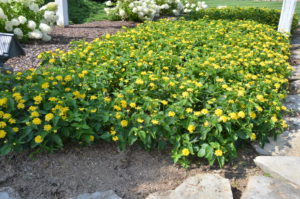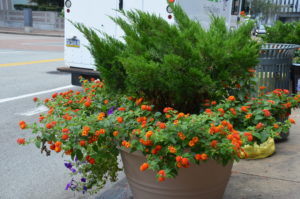Lantanas (Lantana x) are favorite bedding plants, particularly in southern and western U.S. gardens where summers are hot and long. Lantanas are generally planted in flower gardens, but can be grown in containers, including hanging baskets. Plants bloom from late spring until the cool days of fall arrive. Some environmentalists classify them as invasive because birds feed on the abundant berries and distribute the seeds over many miles.
Lantanas like full sun and can grow upright, mounded, spreading , and even trailing depending on cultivar. Feed newly set transplants with a slow release fertilizer such as Osmocote™ or Nutrikote™. An alternative feeding program is to apply a water soluble product such as Miracle-Gro™, Peters™, or Daniels™ every 6-8 weeks from planting time up to late August. Lantanas prosper in a slightly acidic soil.
In areas with long growing seasons such as Florida, Texas or Southern California (zones 9 to 11), plants may be trained into various topiary forms, including miniature trees. Here, lantanas are dependable shrubs or perennials. In cool temperate regions potted plants may be moved to a cool protected place such as a garage or unheated sunroom to overwinter.
Flower heads are small globes of tiny florets. Cultivars come in a wide array of colors from rose pink, yellow, orange or a combination of many flowers. Popular cultivar series include Luscious®, Lucky® and Bandana®. Bandanas grow shorter, about 24-30 inches high, depending on the cultivar. Some gardeners prefer the cultivars ‘New Gold’ and ‘Miss Huff’ that produce sterile seeds and are not invasive.
Disease prevention of problems is always your best alternative. Set lantanas in well-drained soil with good air circulation around plants. Lantana may on occasion succumb to root rot or powdery mildew, particularly when summer weather is unusally wet.
Sooty mold, caused by insect feeding by aphids, mites, and whiteflies, turns leaf surfaces and stems black. Problem pests can be sprayed with several kinds of pesticides or washed off. Plants can also be troubled by tiny sap-sucking lacebugs whose damage leads to leaf drop.
Lantanas are deer resistant and the flowers are favorites of hummingbirds, bees and butterflies. Berries can be toxic to pets and humans and leaves may cause a rash for some people.



 Posted in
Posted in 
